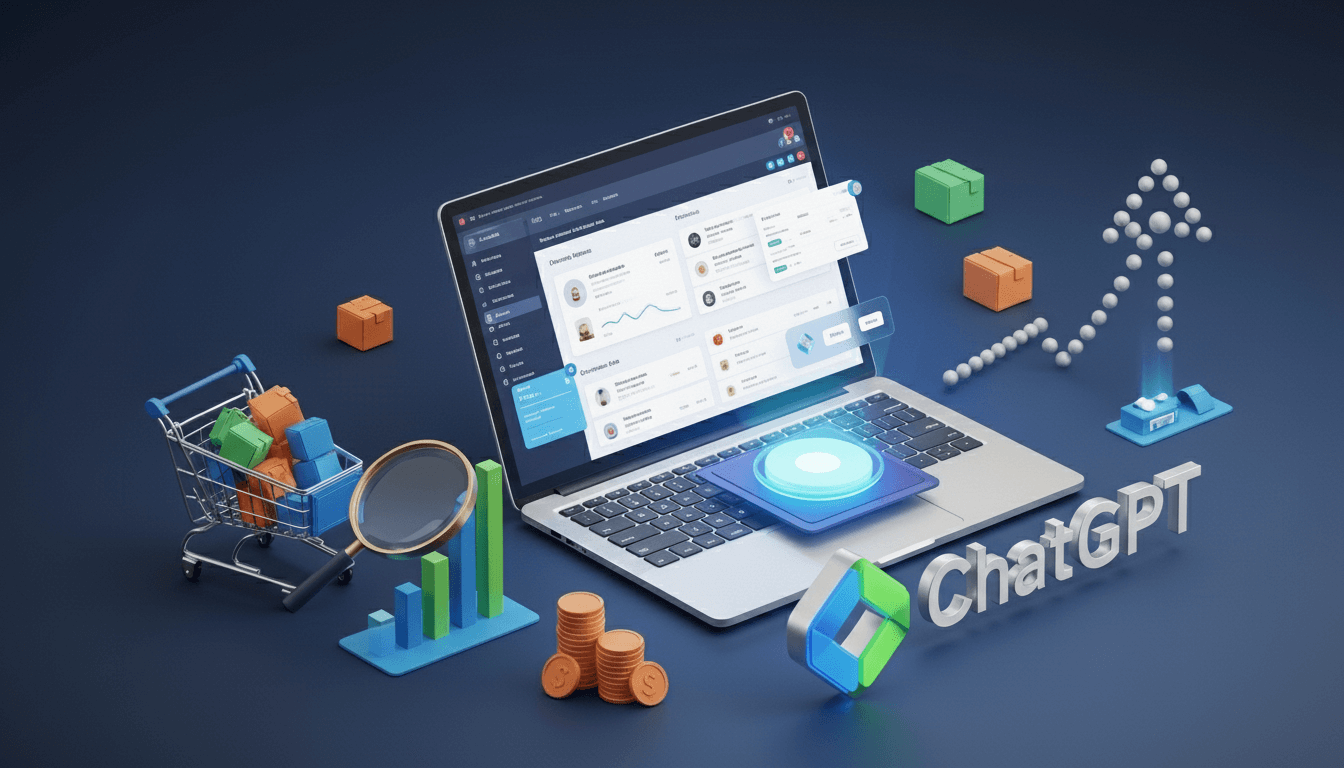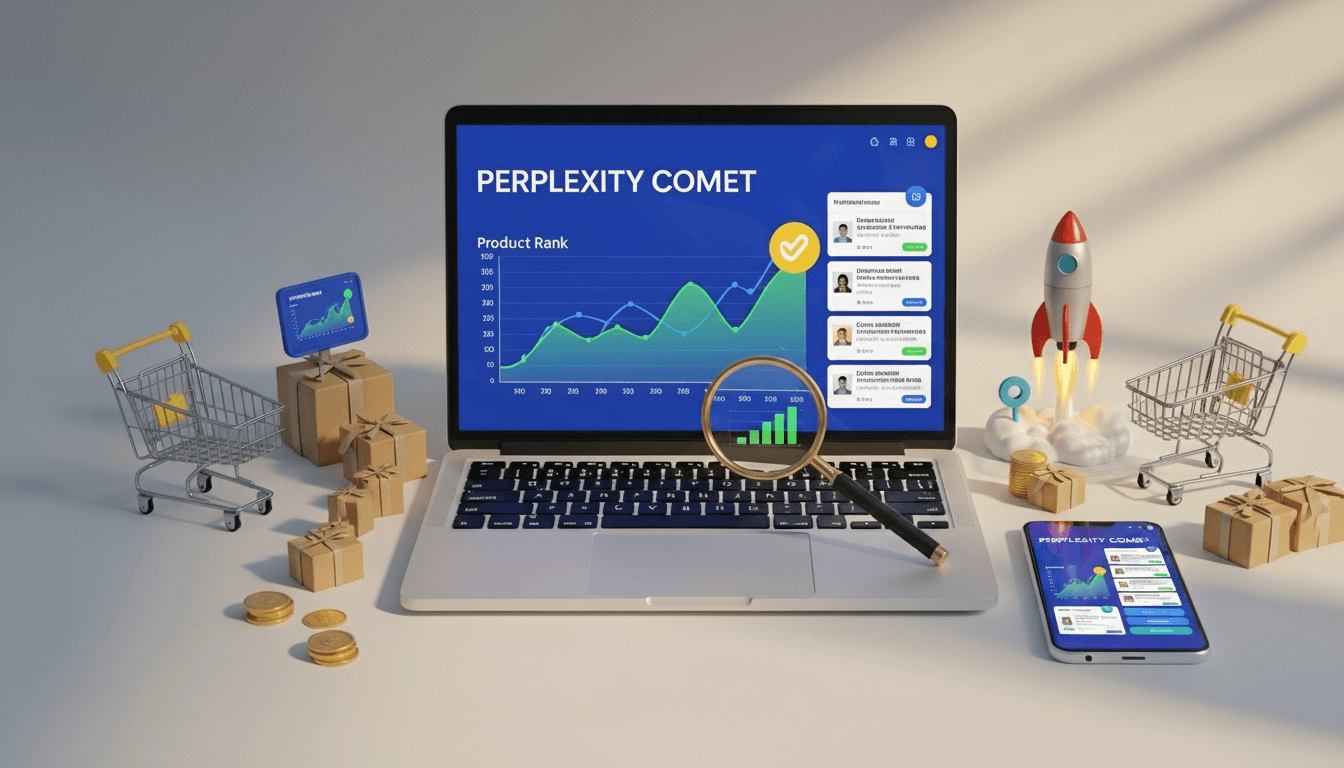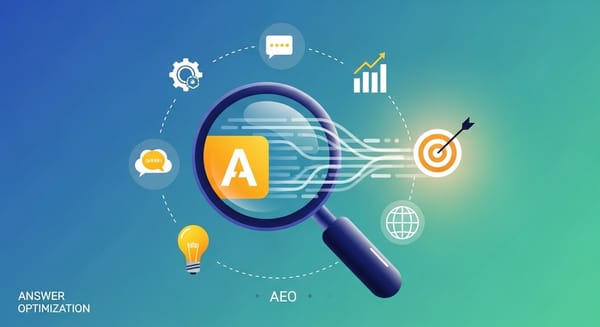How to Rank E-commerce Products on ChatGPT Atlas

Imagine a world where your customers don't search for products. They simply ask their AI assistant to find exactly what they need. E-commerce brands must learn how to optimize their products for AI-driven product discovery with the rise of ChatGPT Atlas. Just as SEO reshaped how brands approached Google, ChatGPT Atlas is changing how we optimize for AI-first product discovery.
Ranking on ChatGPT Atlas is quickly becoming as crucial as ranking on Google or Amazon. In this guide, you’ll learn exactly how Atlas works and the steps needed to optimize your products for Generative Engine Optimization (GEO) and Answer Engine Optimization (AEO).
What is ChatGPT Atlas and Why It Matters for E-commerce
Atlas is not a traditional search engine. Instead, it’s OpenAI’s structured knowledge layer designed to improve answer relevance by pulling in verified, structured content. For e-commerce, this means your product data can now appear directly inside AI-driven conversations, shaping buying decisions without a single “blue link.”
ChatGPT Atlas is OpenAI’s browser that integrates ChatGPT directly into the browsing experience. Instead of relying on traditional search results, Atlas acts as a personal shopping assistant, helping users:
- Compare products instantly
- Summarize reviews
- Find the best deals
- Even complete purchases directly via Agent Mode
Atlas uses the Agentic Commerce Protocol (ACP), developed with Stripe, to let users buy products with Instant Checkout without leaving the chat. This means the shopping journey is AI-first, conversational, and trust-driven.
Key Features Impacting E-commerce
- Agent Mode: Users can do things like ask ChatGPT to make a meal plan for the week and have the built-in AI agent order ingredients from Instacart and have them delivered to your home
- Browser Memory: Optional browser memory will allow users to search through browsing history or pull up documents worked on in Google Docs using natural language
- Direct Shopping Integration: A beta version now allows users to complete purchases without ever leaving ChatGPT, thanks to direct integration with Shopify's payment module
How ChatGPT Atlas Ranks E-commerce product Content
| Factor | Description | Why It Matters |
|---|---|---|
| Structured Data | Schema, product feeds, metadata | Makes products discoverable by AI |
| Domain Authority | Verified, trusted sources | Atlas prioritizes reliability |
| Context Relevance | Product-category-topic alignment | Boosts semantic match with queries |
| User Intent Match | Answers buying-focused queries | Increases conversion relevance |
| Content Freshness | Regular updates & accuracy | Signals trustworthy, active listings |
Unlike Google SEO, Atlas depends more on contextual embeddings + verified data feeds than on backlinks or keyword density.
What are the Strategies to Rank E-commerce Products in ChatGPT Atlas
1. Submit a Structured Product Feed via ACP
Your product feed is the most important asset for GEO. It acts as the AI’s source of truth.
- Register as a merchant with OpenAI’s Product Discovery Interest Form.
- Include structured data attributes like ID, title, description, price, stock, GTIN, MPN, and brand.
- Add optional trust signals: reviews, ratings, return policies.
- Update frequently, daily or more. Freshness matters.
2. Allow OpenAI’s Crawler
To ensure your product pages are indexed:
User-agent: OAI-SearchBot
Disallow:
3. Optimize Product Pages for Conversational Queries
AI assistants rank products based on natural language match, not keyword stuffing.
- Write natural, descriptive titles (up to 150 characters).
- Use long-form descriptions (up to 5,000 characters).
- Answer the "who, what, why, when, how" for each product
- Include benefit-focused descriptions
- Add context for different use cases
- Add FAQ sections that answer common questions.
- Include customer voice, highlight features users mention in reviews like “lightweight” or “durable.”
- Build Topic Clusters and Link PDPs with guides, FAQs, and comparison
- Creates a semantic neighborhood Atlas can read.
- Add Context-Rich Descriptions - Go beyond “what it is” → explain what it solves.
Include use cases, compatibility, specs, and benefits.
4. Build Brand Authority and Social Proof
ChatGPT looks for credibility across the web.
- Encourage authentic mentions on Reddit, Quora, TikTok, and niche review sites.
- Showcase trust signals (return policies, warranties, shipping info).
- Partner with influencers to generate real user discussions.
- Encourage detailed customer reviews
- Include expert testimonials
- Reference industry studies and statistics
- Add manufacturer specifications and certifications
- Create comparison guides with competitors
These external signals make it easier for AI to recommend your products confidently.
5. Track and Measure ChatGPT Traffic
As Atlas grows, you’ll need to measure it as a new channel.
- Use UTM tracking: All outbound clicks from ChatGPT include
utm_source=chatgpt.com. - Monitor brand mentions in AI tools using GEO monitoring platforms.
- Focus on AI references and recommendations instead of just pageviews.
6. Leverage the Shopify Advantage
Shopify stores appear to enjoy advantages, such as streamlined catalog integration, easier feed management, and more consistently filled fields.
If using Shopify:
- Ensure all product fields are completely filled
- Utilize Shopify's built-in schema markup
- Keep product data synchronized
Use Shopify's AI-ready apps and integrations
7. Leverage External Signals (E-E-A-T for AI)
AI models factor in signals beyond your site. Build E-E-A-T:
- Experience: Reviews, tutorials, demo videos.
- Expertise: Certifications, technical details.
- Authority: Backlinks from niche sources.
- Trustworthiness: Transparent brand + policies.
These signals determine which entity Atlas chooses to recommend.
Read more: AI Shopping Optimization for E-commerce
Advanced GEO Techniques for E-commerce
1. Intent-Based Content Optimization
Unlike traditional search engines, which prioritize click-through behavior and backlink profiles, LLMs prioritize contextual relevance driven by how well your content matches the intent behind a query.
Intent Categories to Address:
- Informational: "How does this product work?"
- Investigational: "What are the best options for..."
- Navigational: "Where can I find..."
- Transactional: "Buy [product] with fast shipping"
2. Multi-Modal Content Strategy
With the rise of visual and voice search, generative engines demand multimodal content.
Implementation:
- High-quality product images from multiple angles
- Product demonstration videos
- 360-degree product views
- Voice-optimized descriptions
- AR/VR compatible content where applicable
3. Local and Personalization Signals
Geo-contextual content offers winter coats to users in Chicago and sun hats to Miami shoppers without changing the URL.
Localization Strategies:
- Regional product availability
- Location-specific shipping information
- Local currency and pricing
- Climate-appropriate product suggestions
- Regional size charts and specifications
How to measure E-commerce products ranking in Answer Engines?
- AI Platform Visibility
- Frequency of product appearances in ChatGPT responses
- Citation rates in AI-generated content
- Position within AI recommendations
- Engagement Metrics
- Click-through rates from AI platforms
- Conversion rates from AI-referred traffic
- Average order value from AI channels
- Content Performance
- Schema markup validation scores
- Content completeness ratings
- Update frequency compliance
See more: How to rank your E-commerce products on Perplexity Comet
The FEED Method: Core Pillars for ChatGPT Atlas Ranking Success
Products win when they deliver on four core pillars – what we can call the "FEED" method:
1. Full Data Completeness
- Complete product specifications
- Accurate pricing and availability
- Comprehensive variant information (sizes, colors, materials)
- Rich metadata across all product attributes
2. Expertise and Authority Signals
- Customer reviews and ratings
- Expert endorsements
- Industry certifications
- Authoritative product descriptions
3. Engaging Content Structure
- Clear, conversational product descriptions
- Benefit-led content explaining "who this is for"
- FAQ sections addressing common concerns
- Use case scenarios and applications
4. Dynamic Updates and Freshness
- Real-time inventory synchronization
- Daily feed updates
- Current pricing information
- Seasonal content adjustments
Example Use Case: Ranking a Wireless CarPlay Adapter on ChatGPT Atlas
Imagine you run an e-commerce store selling Wireless CarPlay Adapters. You want your product to appear when a user asks ChatGPT Atlas:
“What is the best wireless CarPlay adapter for Toyota Axio 2018?”
Here’s how you’d optimize step by step:
Step 1: Add Clean Structured Data (Schema Markup)
Your product page should include Product schema in JSON-LD format. For example:
{
"@context": "https://schema.org/",
"@type": "Product",
"name": "Wireless CarPlay Adapter for Toyota Axio (2016–2020 Models)",
"image": "https://example.com/images/wireless-carplay-adapter.jpg",
"description": "Plug-and-play wireless CarPlay adapter compatible with Toyota Axio 2016–2020. Enables fast wireless CarPlay connection in under 2 minutes.",
"sku": "AXIO-WCA-001",
"brand": {
"@type": "Brand",
"name": "DriveConnect"
},
"offers": {
"@type": "Offer",
"url": "https://example.com/wireless-carplay-adapter-axio",
"priceCurrency": "USD",
"price": "99.99",
"availability": "https://schema.org/InStock",
"itemCondition": "https://schema.org/NewCondition"
},
"aggregateRating": {
"@type": "AggregateRating",
"ratingValue": "4.8",
"reviewCount": "246"
}
}
This ensures ChatGPT Atlas can understand:
- What the product is (Wireless CarPlay Adapter)
- Who it’s for (Toyota Axio owners)
- Key details (price, availability, reviews)
Step 2: Optimize Title & Description for Conversational Queries
Instead of writing:
“WCA-001 Adapter”
Write:
“Wireless CarPlay Adapter for Toyota Axio 2016–2020 — Plug & Play, Fast Connection”
In the description, don’t just list specs. Add use cases:
- “Install in under 2 minutes — no tools needed.”
- “Works seamlessly with iPhone 8 and later models.”
- “Compatible with Toyota Axio 2016–2020.”
- “Supports voice commands, maps, and Spotify.”
This matches how people ask in ChatGPT: “Does this work with Toyota Axio 2018?”
Step 3: Build Supporting Content (Semantic Neighborhood)
Create linked content around the product:
- Blog Post → “How to Install a Wireless CarPlay Adapter in 2 Minutes”
- FAQ → “Will this adapter work with Toyota Axio 2018?”
- Comparison Guide → “Wireless vs Wired CarPlay: Which is Better?”
This creates a topic cluster. Atlas sees your product as the answer hub for this category.
Step 4: Add Trust & Social Proof
On the product page, include:
- Verified reviews (e.g., “Works perfectly with my Toyota Axio 2018. Setup took 90 seconds.”)
- Clear shipping policy (“Free shipping in 3–5 days, 30-day return policy”).
- Demo video showing real installation.
These elements are trust signals that AI agents use when deciding which product to recommend.
Step 5: Use Conversational Keywords
Instead of only targeting “Wireless CarPlay Adapter,” optimize for long-tail conversational queries:
- “Best wireless CarPlay adapter for Toyota Axio 2018”
- “Plug-and-play CarPlay adapter under $100”
- “CarPlay adapter compatible with Toyota Axio 2016–2020”
These phrases mirror natural AI queries.
Step 6: Monitor AI Mentions & Traffic
Once optimized, track:
- Referral traffic → Use UTM parameters:
utm_source=chatgpt.com. - Manual testing → Ask ChatGPT: “Best CarPlay adapter for Toyota Axio 2018?” and check if your product appears.
- Review freshness → Update reviews and FAQ answers regularly.
Result: Atlas Ranking Success
When a shopper asks:
“What’s the best wireless CarPlay adapter for Toyota Axio 2018 under $100?”
ChatGPT Atlas can confidently surface your product because:
- Schema markup structured it clearly.
- Descriptions matched the query.
- FAQ content answered compatibility.
- Reviews & ratings built trust.
- Feed updates kept it fresh.
Instead of being buried in Google SERPs, your product is the direct answer inside ChatGPT’s conversation.
What are the Future-Proofing Your E-commerce Strategy
The Agentic Commerce Evolution
Agentic browsers signal a redefinition of how people move from search to purchase. Instead of typing a query, clicking results, and hopping from one merchant to another, users could stay inside the viewport as their browser does the work.
Preparing for Three Shopping Flows
McKinsey & Company described three possible shopping flows:
- Agent to Site: AI sends shoppers directly to your store
- Agent to Agent: Personal AI connects with your store's AI
- Brokered Model: Multiple AI agents interact for optimal outcomes
Conclusion
Ranking in ChatGPT Atlas is not about backlinks or keyword stuffing, it’s about data quality, conversational relevance, and brand trust.
Merchants who adopt Generative Engine Optimization (GEO) today by building structured feeds, optimizing for natural language, and fostering authentic trust signals will dominate tomorrow’s AI-driven shopping experience.
This is more than an SEO update; it’s the beginning of a new era of agentic commerce.
FAQs about Ranking Products in ChatGPT Atlas
ChatGPT ranks products based on structured data, pricing, reviews, and relevance to the user’s query. It is 100% organic, with no paid placements.
Yes. Submitting a structured product feed via ACP is the fastest way to ensure your products appear in ChatGPT Shopping results.
Absolutely. Since there’s no ad bidding, small merchants can compete with large retailers if their data and trust signals are stronger.
Use ChatGPT referral traffic (utm_source=chatgpt.com), conversions, and AI mentions instead of relying only on impressions or clicks.
By treating AI as the new search engine, e-commerce brands can future-proof their digital strategy and secure visibility in ChatGPT Atlas.






